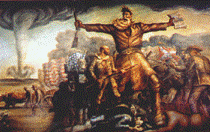History, Department of
Date of this Version
April 2008
Abstract
Riding the crest of a wave that peaked in the 1920s, governmental officials in and around Lake Andes, South Dakota, sought to reorder its cultural and physical landscape. Lake Andes, like so many other communities on the Great Plains, straddled two realities, as it fell within the boundaries of the Yankton Sioux Reservation and, after 1905, was home to a privately developed town. Despite following a relatively uniform impulse, officials from the Bureau of Indian Affairs (BIA) and the South Dakota Department of Agriculture, in conjunction with commercial and educational interests, implemented distinct programs.
Using reports from the BIA farm agent at Lake Andes and newspaper articles chronicling efforts to implement scientific agricultural technologies, this paper argues that the shared vision of scientific agriculture resulted in a narrow conception of permissible behaviors. For Yanktons, these goals required a reordering of both their social and cultural practices and the nonhuman biotic landscape. For white farmers, the transformation demanded adherence to a program of scientifically selected crops and elimination of competitors in the form of chinch bugs and native grasses. Some individuals chose to follows these dictates, while others resisted the plan. Agricultural communities do not arise from simple interactions among soil, water, flora and fauna, but result from a complex exchange among human cultures and nonhuman organisms.


Comments
Paper presented at the 3rd Annual James A. Rawley Conference in the Humanities — Imagining Communities: People, Places, Meanings. Lincoln, Nebraska, April 12, 2008. Sponsored by the University of Nebraska–Lincoln History Graduate Students’ Association. Copyright © 2008 David Nesheim.